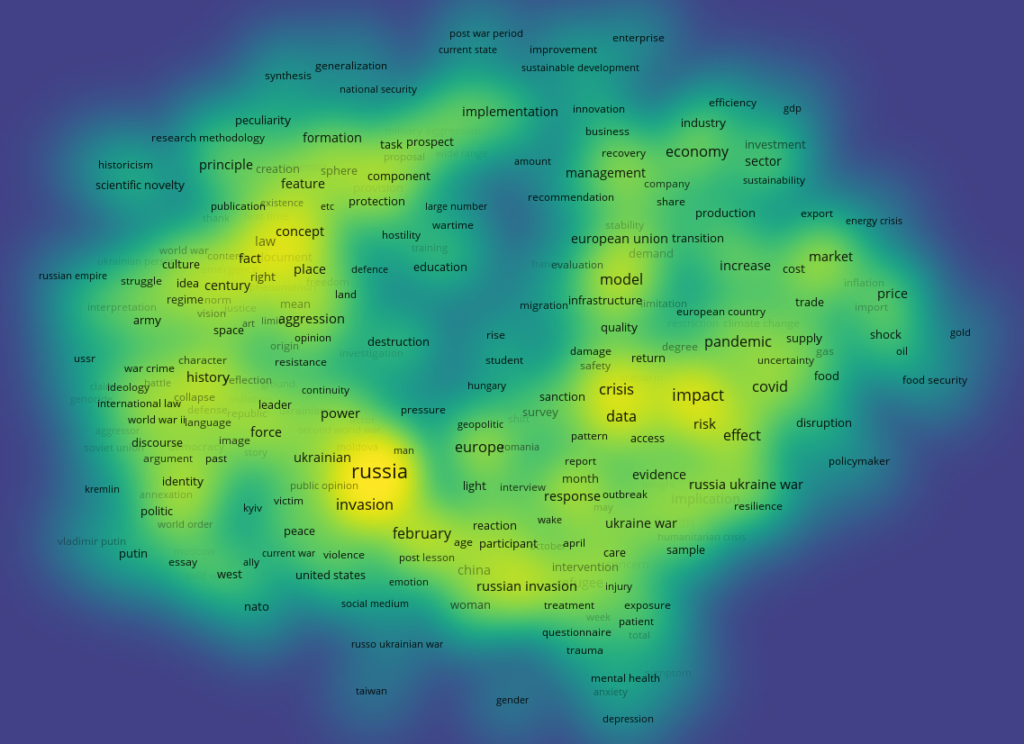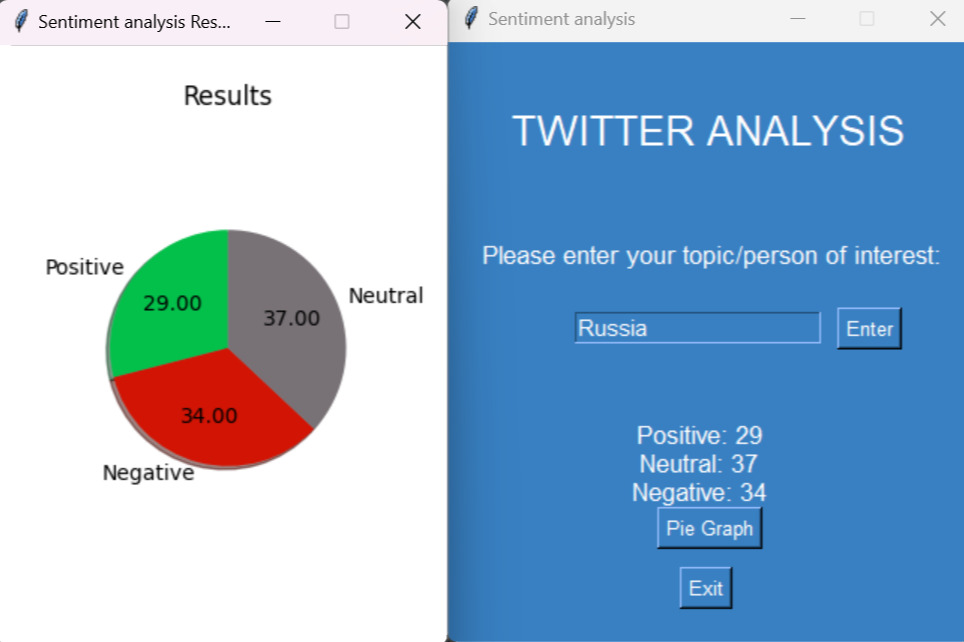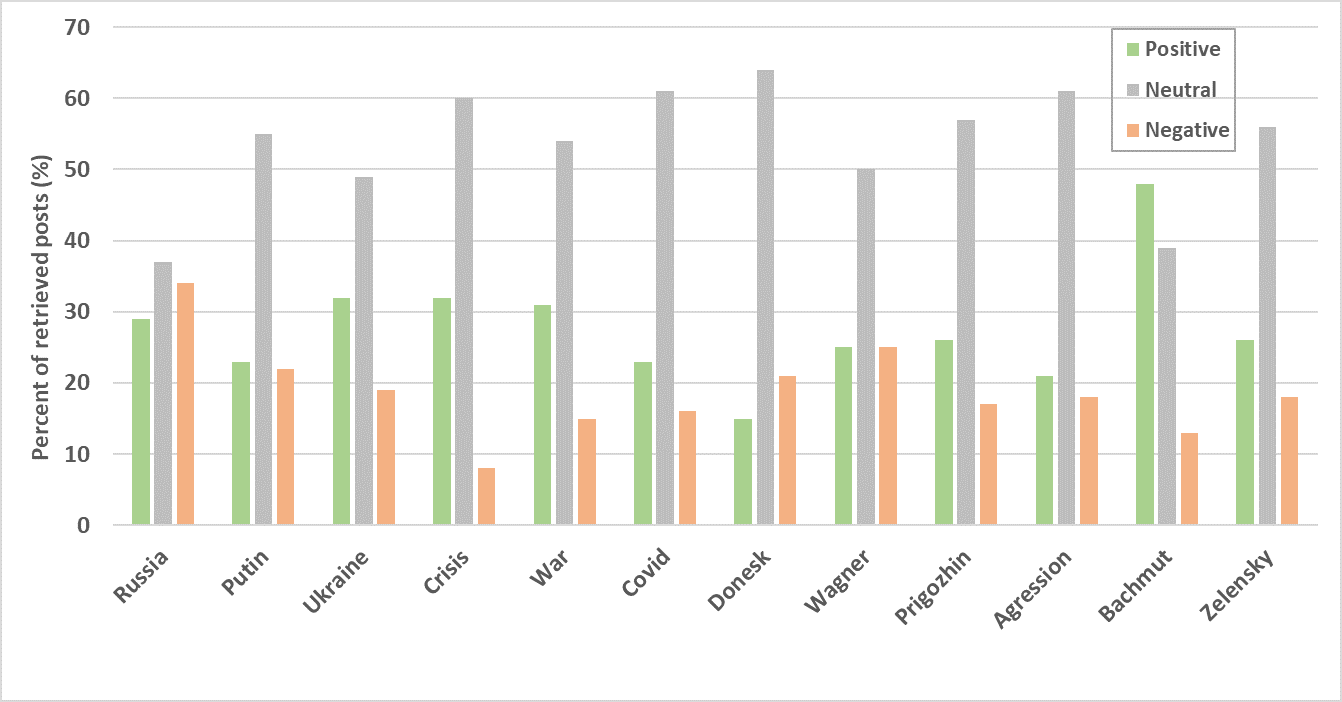Abstract: Nowadays, the internet and social media are probably the most powerful tools used in cognitive warfare to target key figures, niche groups, and significant populations in a community. This article presents a sentiment analysis framework for posts collected from the X social media platform, formerly known as Twitter, on topics related to the Russian-Ukrainian conflict, highlighting the advantages and limitations of using such tools in obtaining information for cognitive warfare.
Problem statement: How to use artificial intelligence to collect and analyse data from social media to gain an advantage in psychological and information warfare?
So what?: Government agencies, military, or intelligence organisations need to define the specific objectives of the cognitive warfare operation and identify the target audience or groups. The responsibility for data retrieval typically falls on intelligence agencies or specialised units within the military that may employ various techniques, including web scraping, social media monitoring, data mining, and open-source intelligence gathering. To this extent, this article presents a simple and straightforward method for automatic data retrieval and sentiment analysis that can be used for initial assessments in cognitive warfare operations. The main results and limitations of the proposed framework are discussed for data posted on the ongoing Russian-Ukrainian war.

Source: shutterstock.com/metamorworks
A New Battlefield
Cognitive warfare involves understanding and influencing human perception, cognition, and behaviour to achieve strategic objectives. It goes beyond traditional military tactics and weaponry and involves using psychological, informational, and communication tools to shape the thoughts and actions of target populations. Cognitive warfare is often described as “the struggle for hearts and minds” because it is the human mind that becomes the battlefield.[1]
Social media platforms have emerged as crucial battlegrounds in this context, as they can influence and manipulate public perceptions, opinions, and behaviours. The growing significance of social media in contemporary warfare has led to its widespread utilisation as a force multiplier, significantly enhancing its role in modern conflicts.[2] Conducting a comprehensive examination of the online information landscape is crucial for governments and institutions as it enables them to enhance their comprehension of public sentiment, identify susceptible audience segments receptive to specific messaging, and detect disinformation endeavours, hostile narratives, and early indications of potential hybrid threats.[3]
Social media platforms have emerged as crucial battlegrounds, as they can influence and manipulate public perceptions, opinions, and behaviours.
Artificial intelligence (AI) has the potential to revolutionise how cognitive warfare is conducted, enabling more sophisticated and effective strategies. AI is a field within computer science that centres on developing intelligent machines with the ability to undertake tasks typically necessitating human intelligence. AI has shown remarkable capabilities in various domains, such as computer vision, machine learning, healthcare, robotics or autonomous systems.[4], [5], [6] The transformation AI brings in cognitive warfare is significant and far-reaching. This article will focus on sentiment analysis, an application that can be used to gauge public opinions, attitudes, and reactions towards specific events, ideas, or individuals.
Sentiment analysis is an application of AI in the field of natural language processing (NLP). It can be used to classify a text into various sentiments, such as positive or negative, happy, sad, or neutral.[7] The field of sentiment analysis, also known as opinion mining, originated by examining subjectivity and sentiment classification, and further evolved to provide multi-language syntax analysis or entity analysis.[8] Various sentiment analysis software packages like Google Cloud Natural Language API, Microsoft Azure Text Analytics API or Lexalytics Salience are currently available on the market and customised for market research, brand management and product/service analysis.[9], [10], [11]
Various sentiment analysis software packages like Google Cloud Natural Language API, Microsoft Azure Text Analytics API or Lexalytics Salience are currently available on the market and customised for market research, brand management and product/service analysis.
It is crucial to emphasise that while sentiment analysis has legitimate and valuable applications in areas such as market research, brand reputation management, and public opinion analysis, its use in cognitive warfare raises serious ethical concerns. Manipulating sentiments, spreading disinformation, or using psychological tactics to influence people’s beliefs and behaviours can negatively affect individuals, societies, and democratic processes. Governments, organisations, and individuals must act responsibly and ethically when leveraging sentiment analysis and other technologies in information warfare. Responsible and ethical practices like transparency and disclosure; respect for privacy; avoiding discrimination, bias, manipulation, and invasive data collection; ensuring data accuracy and reliability should be in place to ensure that cognitive warfare techniques are used accountable and responsible. Specifically, sentimental analysis campaigns should comply with all relevant laws and regulations regarding data privacy, cybersecurity, and information warfare issued by national (National governments, legislative bodies, regulatory authorities) and international regulatory organisations (UN, NATO, EU, ITU). The most important requirement for ensuring responsible and ethical practices in conducting sentimental analysis campaigns is to maintain human oversight in decision-making processes, as human judgment is essential to consider all ethical implications. It is essential to uphold the principles of democracy, free speech, and privacy while navigating the complexities of cognitive warfare and sentiment analysis in this context.
Public literature presents different approaches to sentiment analysis, including lexicon-based techniques, machine-learning-based techniques, and hybrid approaches.[12] Lexicon-based sentiment analysis is a technique used to determine the sentiment or emotion expressed in a piece of text by relying on sentiment lexicons or word lists.[13] In this approach, each word in the text is associated with a sentiment score (e.g., positive, negative, neutral) based on its meaning and context. The overall sentiment of the text is then calculated by aggregating the sentiment scores of individual words. Machine learning-based sentiment analysis is a more advanced approach compared to lexicon-based methods. In this technique, sentiment analysis models are trained on labelled datasets to learn patterns and relationships between words and sentiments.[14], [15], [16] The models use this learned knowledge to predict the sentiment of a new, unseen text.
Hybrid-based sentiment analysisis an approach combining multiple techniques or methods, such as lexicon-based, rule-based, and machine learning-based approaches, to perform sentiment analysis on textual data.[17] This hybrid approach aims to leverage each method’s strengths and overcome their limitations, resulting in a more accurate and robust sentiment analysis system.
Sentiment analysis holds significant relevance in the context of international crises like the ongoing Russian-Ukrainian conflict that has attracted much media attention due to its geopolitical implications, humanitarian consequences, and impact on regional and global stability. Authors found only two publications on sentiment analysis performed on the Russian-Ukrainian conflict, both published in 2023. One research paper provides insights into public opinion regarding the Russian-Ukrainian conflict using machine learning techniques and social media data.[18] The study uses sentiment analysis and text analytics to analyse the tweets related to the Russian-Ukrainian conflict collected from the former Twitter social media platform and classifies them into negative, positive, or neutral sentiments. Three featured extraction techniques, namely TF-IDF, Bag of Words (BoW), and N-gram, are utilised to extract features from the tweets. The results show that the Extra Trees Classifier model achieves the highest accuracy of 84% when combined with the BoW feature extraction technique.
The other identified research paper extracts and analyses the sentiments expressed by Ukrainian Telegram users based on data collected during the initial two months of conflict in Ukraine.[19] The results of this study present a classification of the main topics on Telegram as being mainly related to the attack, particular cities and events, sanctions, children, and refugees. The authors of this research paper appreciate the scarcity of publicly available research papers containing datasets related to the ongoing Russian-Ukrainian conflict.
X social media platform, formerly known and further referred to as Twitter, stands out as one of the most extensively utilised microblogging social media platforms, producing an immense volume of opinionated data in tweets daily.[20] Consequently, the content from the social media platform is a convenient option for conducting sentiment analyses and various other research studies.
X social media platform, formerly known and further referred to as Twitter, stands out as one of the most extensively utilised microblogging social media platforms, producing an immense volume of opinionated data in tweets daily.
Therefore, to complete the already published research literature, we further explore the potential of AI tools for providing cognitive warfare advantages and present the development and implementation of sentiment analysis performed on posts collected from Twitter social media platform on the Russian-Ukrainian conflict. The development and implementation of sentiment analysis performed on posts collected from the Twitter social media platform on selected topics will provide insights into the impact of influential events, narratives, and key factors/actors on the public’s perception of the Russian-Ukrainian conflict. The originality of this approach lies in using a bibliometric analysis conducted on the Web of Science research platform to obtain a network visualisation of the common terms in the most recent publications related to the war in Ukraine. The obtained keywords were then used to trigger automatic Twitter post retrieval, which were inputted into the custom-developed lexicon-based sentiment analysis software.
Research Methodology
The main objective of this research was to conduct sentiment analysis to investigate the polarity of different topics collected from the Twitter social media platform on the ongoing Russian-Ukrainian conflict. The topics searched for on the media platform were selected based on the results of a bibliometric analysis performed on articles published in the Web of Science (WoS) Clarivate Analytics database in 2022 and 2023.

Research methodology; Source: Authors
Bibliometric analysis is a quantitative research method involving statistical analysis of scholarly publications, including books, journals, conference papers, and other academic documents. It was used to assess the interrelationships of publications available in the WoS database, containing the words Ukraine and War in the title, abstract, or keywords published between 2022 and 2023. The database was searched in June 2023, and the result indicated 2,376 publications. These publications were exported and then imported into the VOSviewer software to construct and visualise the co-term occurrence map. VOSviewer is a popular bibliometric analysis tool that helps visualise and analyse bibliometric data.[21] The minimum number of term occurrences considered was 20. As a result, the resulting co-occurrence terms were mapped.

Co-occurrence term mapping for articles published in WoS in 2022/2023 containing the words Ukraine and War; Source: Authors
Terms with higher occurrence are written using a higher font number. Thus, one can extract the following words related to our search: Russia, invasion, crisis, impact, COVID, force, power and Europe. In the next phase, one can use the terms with the highest occurrence on the map to trigger post searches on the Twitter platform. Web scraping, an automated method of extracting information and data from Twitter quickly and efficiently, saving time and effort compared to manual data extraction, is useful in this regard. Python software was used for automatic tweet collection.

Workflow for automatic tweet retrieval; Source: Authors
To automatically collect tweets (Twitter posts), first, one must obtain credentials for a Twitter developer account containing the consumer keys and the access token to the Twitter platform.
Posts were collected using the search_recent_tweets function, which outputs the most recent tweets searched by a keyword or hashtag. The parameters of the search_recent_tweets function are the number of posts to be inserted in the data frame (max_results) and the query. A data frame is then generated and populated with all the posts extracted from the Twitter platform, including information about the post’s content and its ID.
After the Twitter posts collection and data frame construction, the preconditions are set to apply sentiment analysis to the collected data.

Sentiment analysis workflow; Source: Authors
Sentiment analysis is a research method that falls under the broader category of NLP and is primarily associated with text analysis. It can also be classified as a quantitative research method, as it involves systematically analysing textual data to extract and quantify the sentiment expressed within the text.
TextBlob is a popular Python library that provides simple and easy-to-use tools for various NLP tasks, including sentiment analysis. It uses a pre-trained sentiment analysis model to analyse text and classify the expressed sentiment. TextBlob functions as a lexicon-driven Sentiment Analyzer, leveraging a set of pre-established rules and a word-weight dictionary. This lexicon contains assigned scores that contribute to the computation of the polarity of a given sentence. The polarity value indicates the sentiment of the text, where a positive value indicates positive sentiment, a negative value indicates negative sentiment, and a value close to 0 indicates neutral sentiment. Because TextBlob’s sentiment analysis is based on a lexicon-driven approach, it might not be as accurate or nuanced as more specialised models that employ machine learning and deep learning. However, it is very simple to use and straightforward and achieves the research objective of proving AI’s usability in obtaining information from a social media platform.
TextBlob is a popular Python library that provides simple and easy-to-use tools for various NLP tasks, including sentiment analysis. It uses a pre-trained sentiment analysis model to analyse text and classify the expressed sentiment.
Each tweet in the list of collected tweets was labelled depending on the language used, keywords found, punctuation marks, and certain phrases that can be interpreted as positive or negative. Usually, statements about a particular topic or news item were classified as neutral posts with 0 polarity. This suggests that the language used in those statements is neutral and doesn’t convey a strong emotional opinion regarding the topic or news item being discussed. These types of statements are often factual or objective in nature, presenting information without expressing a clear positive or negative attitude. A new data frame was created containing the polarity label of the collected tweet and the post content. Finally, a customised user interface was designed for automatic retrieval of Twitter posts and sentiment analysis based on the selected topic of interest.

Twitter sentiment analysis graphical user interface; Source: Authors
Due to the limitations of the subscription plan, we have retrieved only a limited number of tweets (100) on each topic. The designed GUI also enables data visualisation using a pie-type graph to provide the polarity of the collected tweets.
Results and Discussion
For most observations, the algorithm classifies most of the tweets as neutral. A neutral result in sentiment analysis using TextBlob means that the analysed text doesn’t exhibit a strong positive or negative sentiment. It suggests that the text’s content is relatively objective and lacks emotional intensity or bias towards either a positive or negative viewpoint. When TextBlob assigns a neutral sentiment to a text, it typically means that the polarity score, which ranges from -1 (very negative) to 1 (very positive), is close to 0, indicating a lack of clear sentiment. It’s important to note that sentiment analysis is not always perfect, and sometimes, even human readers might interpret a text differently in terms of sentiment. Additionally, the accuracy of sentiment analysis can vary depending on factors such as language complexity, context, and the specific algorithm used by TextBlob, as the search was not geographically limited and only English language posts were collected.
Below is an example of a collected post that was classified with a positive sentimental analysis polarity score (+0,46) and exhibits a strong positive sentiment in the expressed idea:
- The people of Kherson are amazing and show once again their resourcefulness and quick adaptation to changing conditions.
This is the most favourable use case of sentimental analysis. However, there are also cases when the lexicon-based approach cannot detect sarcasm or irony. Below is an example that was classified as a positive post with a +0.6 polarity score, while a human reader can easily detect sarcasm in the post.
- You can be friends with Russia – it’s kind. You can cooperate with Russia – it’s honest.
Another example of the algorithm not accurately capturing the polarity score is given for the following very strong negative post that was given only a -0.2 polarity score.
- Russia destroyed the oldest church in Odesa, the Transfiguration Orthodox Cathedral, a protected UNESCO world heritage site.
An indisputable example of a negative polarity score (-0.374) is given below, clearly detecting the negative sentiment towards the Russian actions.
- Russia is dumb thinking blowing up the church buildings and others will erase Ukrainian culture.

Sentiment analysis results on various topics; Source: Author
If we neglect neutral polarity scores and focus on the positive/negative polarity posts, we can observe that more posts related to Russia are classified as negative as opposed to Ukraine, on which more positive posts are found. The negative polarity of sentiment analysis for Russia in the Russia-Ukraine war, as opposed to the positive polarity for Ukraine, can be motivated by several key factors and perspectives, including aggressor versus victim perception, international opinion, humanitarian consequences, economic sanctions and global support for Ukraine.
Intelligence agencies and communication specialists can use sentiment analysis to understand public opinion trends and craft strategic messaging that aligns with the negative sentiment toward Russia, emphasising Ukraine’s victim status and Russia’s aggression. Government agencies and diplomatic missions can leverage the negative sentiment toward Russia to advocate for international sanctions, condemn Russian actions, and build diplomatic pressure on Russia to adhere to international norms. Media outlets and fact-checking organisations can use sentiment analysis to identify and counter disinformation campaigns originating from sources associated with the negative sentiment, helping to debunk false narratives. Research institutions and security organisations can use sentiment analysis to assess the potential risks associated with negative sentiment, such as the likelihood of protests, cyberattacks, or other forms of public unrest.
Intelligence agencies and communication specialists can use sentiment analysis to understand public opinion trends and craft strategic messaging that aligns with the negative sentiment toward Russia, emphasising Ukraine’s victim status and Russia’s aggression.
Specific information units, such as government agencies, intelligence organisations, research institutions, or media outlets, should analyse these sentimental analysis results and maintain human oversight in decision-making processes to develop successful information warfare actions.
The results of the applied sentiment analysis algorithm must be analysed by considering the tool’s limitation in accurately capturing the sentiment polarity behind a given text. Using the straightforward, user-friendly tool TextBlob, for sentiment analysis comes with a notable trade-off. Its analysis is largely based on pattern matching and a pre-trained model, which can lead to misinterpretations of context, sarcasm, and nuanced language. Domain-specific sentiments might be inaccurately classified, as this library lacks customisation for specialised industries. The tool’s reliance on a positive, negative, or neutral polarity scale oversimplifies sentiment, missing subtler emotional nuances. Moreover, incomplete or inaccurate results might be obtained for non-English texts, informal language, and longer texts. Overall, its inability to handle more nuanced emotions and domain-specific language limits its effectiveness in providing sophisticated sentiment analysis.
Advanced Sentiment Analysis Powered by AI
Using Python’s TextBlob for sentiment analysis in the context of cognitive warfare has both advantages and limitations. On the positive side, TextBlob provides a relatively simple and accessible way to analyse sentiment in textual content, making it a convenient choice for initial assessments. It can assist in identifying broad trends and patterns of sentiment within propaganda, disinformation, or psychological warfare campaigns. However, due to the complex and context-dependent nature of cognitive warfare, TextBlob’s limitations, such as its difficulty in understanding sarcasm, domain-specific language, and nuanced emotions, could lead to misinterpretations. When dealing with strategic and potentially high-stakes situations like cognitive warfare, relying solely on TextBlob might not be sufficient. It’s crucial to complement its use with human expertise, domain knowledge, and possibly more advanced sentiment analysis techniques to ensure accurate and reliable insights into information warfare efforts’ emotional and psychological impact.
Enhancing lexicon-based sentiment analysis by integrating machine learning techniques represents a crucial advancement in cognitive warfare. While lexicon-based methods offer a foundational understanding of sentiment in text, the complex and evolving tactics of psychological manipulation demand a more adaptive approach. By leveraging machine learning algorithms, this fusion not only refines sentiment polarity detection but also enables the recognition of subtle emotional nuances that can be strategically harnessed in information warfare. The machine learning-enhanced framework, continuously learning from vast and diverse datasets, equips analysts with a dynamic tool capable of deciphering context-specific sentiment shifts, effectively countering the evolving landscape of cognitive warfare.
While lexicon-based methods offer a foundational understanding of sentiment in text, the complex and evolving tactics of psychological manipulation demand a more adaptive approach.
For the selected case study, the polarity of sentiment analysis for Russia in the Russia-Ukraine conflict, contrasting with the positivity observed for Ukraine, is influenced by multifaceted factors, including the perceptions of aggressor versus victim, international consensus, humanitarian consequences, economic sanctions, and global support. Intelligence agencies and diplomatic missions can strategically leverage this sentiment to advance diplomatic and information warfare objectives, while media outlets and research institutions play pivotal roles in countering disinformation and assessing associated risks. Similarly, the shift towards positive sentiment in posts related to crises and the COVID pandemic raises intriguing possibilities about public perception. This shift could reflect evolving public views as crises reach their downturn or conversely signify orchestrated campaigns to influence public behaviour. Information units should critically analyse sentiment analysis outcomes, maintain human oversight, and consider the limitations of sentiment analysis tools to craft effective information warfare strategies and nuanced narratives.
A responsible entity could leverage sentiment analysis performed on posts collected on the Russia-Ukraine conflict as a valuable tool for informed decision-making and effective communication. By monitoring public sentiment, this entity can gain insights into the evolving perceptions and emotions of the populations affected by the conflict, as well as the international community. This data-driven approach can inform diplomatic strategies, early warning systems and policy development that is more attuned to the sentiments of various stakeholders. Additionally, sentiment analysis can help identify and counteract propaganda and disinformation campaigns, ensuring the integrity of information dissemination. Furthermore, it can be instrumental in crisis management, facilitating humanitarian aid efforts, and tailoring communication strategies that resonate with the public, ultimately contributing to a more informed, empathetic, and responsive approach to addressing the complex dynamics of the Russia-Ukraine conflict.
In the arena of cognitive warfare, where information is a potent weapon and perceptions are battlegrounds, the quest for a suitable sentiment analysis approach becomes significant. In pursuing a suitable sentiment analysis framework for cognitive warfare, one must consider the equilibrium defined by the combination of AI use and ethical concerns. Striking a balance between harnessing sentiment analysis for strategic insights and safeguarding against potential misuse must be considered a primary concern.
In pursuing a suitable sentiment analysis framework for cognitive warfare, one must consider the equilibrium defined by the combination of AI use and ethical concerns.
Undoubtedly, in the ever-evolving landscape of cognitive warfare, the synergy between advanced sentiment analysis powered by AI is a pivotal tool in deciphering the enigmatic fabric of emotions that underlie strategic information manipulation.
Cpt.asst.prof. Annamaria Sârbu, PhD; Research interest: electromagnetic fields, spectrum monitoring, data science; ORCID ID 0000-0001-9061-8573. Cadet Gavrilaș Anca, IV-th year cadet studying engineering and management in military communications; Research interest: artificial intelligence, electronics. The views contained in this article are the author’s alone and do not represent the views of “Nicolae Bălcescu” Land Forces Academy, Sibiu, Romania.
[1] Robert Reczkowski, and Andrzej Lis, “Cognitive Warfare: What Is Our Actual Knowledge and How to Build State Resilience?,” JB. Bezpieczeństwo, Teoria i Praktyka 3 (XLVIII): 51–62, https://doi.org/10.48269/2451-0718-btip-2022-3-003 .
[2] Long Chen, Jianguo Chen, and Chunhe Xia, “Social Network Behavior and Public Opinion Manipulation,” Journal of Information Security and Applications, Elsevier BV, February 2022, https://doi.org/10.1016/j.jisa.2021.103060.
[3] Sebastian Bay, Giorgio Bertolin, Nora Biteniece, Edward H. Christie, Anton Dek, Rolf E. Fredheim, John D. Gallacher, Kateryna Kononova, Tetiana Marchenko “Responding to cognitive security challenge,“ Riga, January 2019, NATO Stratcom COE.
[4] E. Kutlugün and C. Eyüpoğlu, “Artificial Intelligence Methods Used in Computer Vision,” 2020 5th International Conference on Computer Science and Engineering (UBMK), Diyarbakir, Turkey, 2020, 214-218, doi: 10.1109/UBMK50275.2020.9219385.
[5] Annamaria Sârbu, Mirela Șorecău, Emil Șorecău, and Paul Bechet, “Machine-Learning-Based Classification of Frequency Hopping in Radio Networks for Communication Reconnaissance,” International Conference KNOWLEDGE-BASED ORGANIZATION, Walter de Gruyter GmbH, https://doi.org/10.2478/kbo-2023-0079.
[6] Albert Feisal Muhd Feisal Ismail, Mohd Fazli Mohd Sam, Kamarudin Abu Bakar, Amiruddin Ahamat, Sabrinah Adam, and Muhammad Imran Qureshi, “Artificial Intelligence in Healthcare Business Ecosystem,” International Journal of Online and Biomedical Engineering (iJOE), International Association of Online Engineering (IAOE), https://doi.org/10.3991/ijoe.v18i09.32251.
[7] R Raja Subramanian, Nukala Akshith, Gogula Narasimha Murthy, Manchala Vikas, Srikar Amara, and Kamam Balaji, “A Survey on Sentiment Analysis,” 2021 11th International Conference on Cloud Computing, Data Science & Engineering (Confluence), IEEE, January 28, 2021, https://doi.org/10.1109/confluence51648.2021.9377136.
[8] A. B. Pawar, M. A. Jawale, and D. N. Kyatanavar, “Fundamentals of Sentiment Analysis: Concepts and Methodology,” Sentiment Analysis and Ontology Engineering, Springer International Publishing, 2016, https://doi.org/10.1007/978-3-319-30319-2_2.
[9] Ehsan Kamalloo and Davood Rafiei, “A Coherent Unsupervised Model for Toponym Resolution,” Proceedings of the 2018 World Wide Web Conference (2018), https://doi.org/10.1145/3178876.3186027.
[10] Osama Harfoushi, Dana Hasan and Ruba Obiedat, “Sentiment Analysis Algorithms through Azure Machine Learning: Analysis and Comparison,” Modern Applied Science (2018), https://doi.org/10.5539/MAS.V12N7P49.
[11] https://www.lexalytics.com/salience/, last accessed on August 02, 2023.
[12] Nhan Cach Dang, María N. Moreno-García, and Fernando De la Prieta, “Sentiment Analysis Based on Deep Learning: A Comparative Study,” Electronics 9, no. 3: 483, https://doi.org/10.3390/electronics9030483.
[13] Hongyu Han, Jianpei Zhang, Jing Yang, Yiran Shen and Yongshi Zhang, “Generate domain-specific sentiment lexicon for review sentiment analysis,” Multimedia Tools and Applications, 77 (2018): 21265-21280, https://doi.org/10.1007/s11042-017-5529-5.
[14] Joko Eliyanto Sugiyarto, Nursyiva Irsalinda, and Meita Fitrianawati, “Fuzzy Sentiment Analysis Using Convolutional Neural Network,” INTERNATIONAL CONFERENCE ON MATHEMATICS, COMPUTATIONAL SCIENCES AND STATISTICS 2020, AIP Publishing, 2021, https://doi.org/10.1063/5.0042144.
[15] Kavita Moholkar, Krupa Rathod, Krishna Rathod, Mritunjay Tomar, and Shashwat Rai, “Sentiment Classification Using Recurrent Neural Network,” Intelligent Communication Technologies and Virtual Mobile Networks, Springer International Publishing, August 13, 2019,https://doi.org/10.1007/978-3-030-28364-3_49.
[16] JianHua Yuan, Yang Wu, Xin Lu, YanYan Zhao, Bing Qin, and Ting Liu, “Recent Advances in Deep Learning Based Sentiment Analysis,” Science China Technological Sciences, Springer Science and Business Media LLC, September 15, 2020, https://doi.org/10.1007/s11431-020-1634-3.
[17] Y. Cai, Kai Yang, Dongping Huang, Zikai Zhou, Xue Lei, Haoran Xie and Tak-Lam Wong, “A hybrid model for opinion mining based on domain sentiment dictionary,” International Journal of Machine Learning and Cybernetics (2019): 1-12, https://doi.org/10.1007/S13042-017-0757-6.
[18] Ganesh Kumar Wadhwani, Pankaj Kumar Varshney, Anjali Gupta, and Shrawan Kumar, “Sentiment Analysis and Comprehensive Evaluation of Supervised Machine Learning Models Using Twitter Data on Russia–Ukraine War,” SN Computer Science. Springer Science and Business Media LLC, https://doi.org/10.1007/s42979-023-01790-5.
[19] Clara Maathuis and Iddo Kerkhof, “The First Two Months in the War in Ukraine through Topic Modeling and Sentiment Analysis,” Regional Science Policy & Practice, Wiley, https://doi.org/10.1111/rsp3.12632.
[20] Vishal Gaba and Vijay Verma, “Sentiment Analysis of Twitter Data Using Machine Learning Approaches,” Soft Computing and Its Engineering Applications, Springer International Publishing,https://doi.org/10.1007/978-3-031-05767-0_12.
[21] Jan van Eck Nees and L. Waltman, “Software survey: VOSviewer, a computer program for bibliometric mapping,” Scientometrics, 84 (2009): 523 – 538, https://doi.org/10.1007/s11192-009-0146-3.






